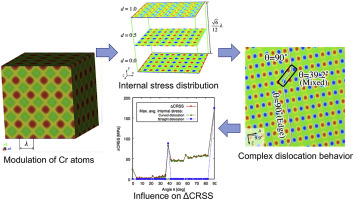当前位置:
X-MOL 学术
›
Acta Mater.
›
论文详情
Our official English website, www.x-mol.net, welcomes your feedback! (Note: you will need to create a separate account there.)
Influence of spinodal decomposition structures on the strength of Fe-Cr alloys: A dislocation dynamics study
Acta Materialia ( IF 9.4 ) Pub Date : 2018-03-01 , DOI: 10.1016/j.actamat.2017.12.051 A. Takahashi , T. Suzuki , A. Nomoto , T. Kumagai
Acta Materialia ( IF 9.4 ) Pub Date : 2018-03-01 , DOI: 10.1016/j.actamat.2017.12.051 A. Takahashi , T. Suzuki , A. Nomoto , T. Kumagai

|
Abstract This paper presents a numerical analysis of the influence of spinodal decomposition on the strength of Fe-Cr alloys using the dislocation dynamics (DD) method. In the DD simulations, the structure of a spinodally decomposed chromium distribution is approximated using a cosine function. Using the equation for internal stress distribution, the interaction between a dislocation and the internal stress distribution is precisely accounted for in the DD simulations. The structure of the spinodally decomposed chromium distribution is parameterized using four variables, including the magnitude of chromium concentration, wave length of chromium distribution, position of the slip plane of dislocation, and the dislocation character (angle between the dislocation line and Burgers vector). Using these variables, the influence of the structure of chromium distribution on the critical resolved shear stress (CRSS) is studied. Furthermore, we focused on two major slip systems of the BCC structure, { 110 } 〈 111 〉 and { 112 } 〈 111 〉 , and discuss the difference in the influence between the different slip systems. In the { 110 } 〈 111 〉 slip system, the Δ CRSS appears only for a mixed dislocation with θ = 54.7°, because of the stripe pattern of the resolved shear stress distribution. On the other hand, in the { 112 } 〈 111 〉 slip system, the dislocations with θ = 39.2° and 90° have a large Δ CRSS. There is a plateau of Δ CRSS in a range of 39.2 ∘ θ 90 ∘ . The slip plane position does not change the Δ CRSS. There is a dependence of Δ CRSS on the wave-length of the chromium distribution. The dependence of Δ CRSS on the wave-length can be found not with a straight dislocation but with a curved dislocation using the DD simulations. The information is a new finding, and is meaningful in understanding the relationship between the material strength and the structure of spinodal decomposition.
中文翻译:

旋节线分解结构对铁铬合金强度的影响:位错动力学研究
摘要 本文采用位错动力学(DD) 方法数值分析了旋节线分解对Fe-Cr 合金强度的影响。在 DD 模拟中,旋节线分解铬分布的结构使用余弦函数近似。使用内部应力分布方程,位错和内部应力分布之间的相互作用在 DD 模拟中得到精确解释。旋节线分解铬分布的结构使用四个变量进行参数化,包括铬浓度的大小、铬分布的波长、位错滑移面的位置和位错特征(位错线与 Burgers 矢量之间的角度)。使用这些变量,研究了铬分布结构对临界分辨剪应力(CRSS)的影响。此外,我们重点讨论了 BCC 结构的两个主要滑移系统 {110}<111> 和 {112}<111>,并讨论了不同滑移系统之间影响的差异。在 { 110 } 〈 111 〉滑移系统中,Δ CRSS 仅出现在 θ = 54.7° 的混合位错中,因为解析的剪切应力分布的条纹图案。另一方面,在{112}<111>滑移系统中,θ=39.2°和90°的位错具有较大的ΔCRSS。Δ CRSS 在 39.2 ∘ θ 90 ∘ 范围内有一个平台。滑移面位置不会改变 Δ CRSS。Δ CRSS 依赖于铬分布的波长。Δ CRSS 对波长的依赖性不是用直位错而是用 DD 模拟发现的弯曲位错。该信息是一项新发现,对理解材料强度与旋节线分解结构的关系具有重要意义。
更新日期:2018-03-01
中文翻译:

旋节线分解结构对铁铬合金强度的影响:位错动力学研究
摘要 本文采用位错动力学(DD) 方法数值分析了旋节线分解对Fe-Cr 合金强度的影响。在 DD 模拟中,旋节线分解铬分布的结构使用余弦函数近似。使用内部应力分布方程,位错和内部应力分布之间的相互作用在 DD 模拟中得到精确解释。旋节线分解铬分布的结构使用四个变量进行参数化,包括铬浓度的大小、铬分布的波长、位错滑移面的位置和位错特征(位错线与 Burgers 矢量之间的角度)。使用这些变量,研究了铬分布结构对临界分辨剪应力(CRSS)的影响。此外,我们重点讨论了 BCC 结构的两个主要滑移系统 {110}<111> 和 {112}<111>,并讨论了不同滑移系统之间影响的差异。在 { 110 } 〈 111 〉滑移系统中,Δ CRSS 仅出现在 θ = 54.7° 的混合位错中,因为解析的剪切应力分布的条纹图案。另一方面,在{112}<111>滑移系统中,θ=39.2°和90°的位错具有较大的ΔCRSS。Δ CRSS 在 39.2 ∘ θ 90 ∘ 范围内有一个平台。滑移面位置不会改变 Δ CRSS。Δ CRSS 依赖于铬分布的波长。Δ CRSS 对波长的依赖性不是用直位错而是用 DD 模拟发现的弯曲位错。该信息是一项新发现,对理解材料强度与旋节线分解结构的关系具有重要意义。



























 京公网安备 11010802027423号
京公网安备 11010802027423号